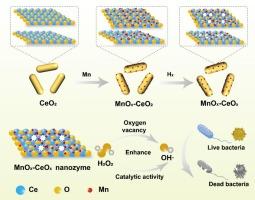具有富氧结构的MnOx-CeOx共生纳米酶用于增强抗菌治疗
IF 5.4
3区 化学
Q1 CHEMISTRY, INORGANIC & NUCLEAR
引用次数: 0
摘要
开发用于抗菌治疗的高性能纳米酶对于应对全球公共卫生挑战至关重要。本文报道了一种通过H2激活策略合成的具有丰富氧空位(Ovs)的新型MnOx-CeOx纳米酶,该酶具有优异的过氧化物酶样(POD)活性和广谱抗菌功效。采用经典的两步水热法合成了均匀的CeO2纳米棒,然后通过原子层沉积在表面生长MnOx。随后的H2还原将Ovs引入MnOx-CeOx体系,显著提高了其催化性能。研究表明,富含ov的结构有利于有效的电子转移,使纳米酶能够催化过氧化氢成为羟基自由基作为主要的活性氧。优化后的MnOx-CeOx纳米酶对金黄色葡萄球菌和大肠杆菌都具有很强的抗菌活性,在弱酸性条件下几乎完全消灭细菌。这项工作为通过缺陷工程设计高性能纳米酶提供了一种战略途径,为无抗生素抗菌治疗提供了有希望的解决方案。本文章由计算机程序翻译,如有差异,请以英文原文为准。

MnOx-CeOx symbiotic nanozyme with oxygen vacancy-enriched structure for enhanced antibacterial therapy
The development of high-performance nanozymes for antibacterial treatment is critical to addressing global public health challenges. Herein, we report a novel MnOx-CeOx nanozyme with abundant oxygen vacancies (Ovs), synthesized via a H2 activation strategy, which exhibits exceptional peroxidase-like (POD) activity and broad-spectrum antibacterial efficacy. Uniform CeO2 nanorods were synthesized using a classic two-step hydrothermal method, followed by the growth of MnOx on the surface via atomic layer deposition. Subsequent H2 reduction introduced Ovs into the MnOx-CeOx system, significantly enhancing its catalytic performance. Studies reveal that the Ov-rich structure facilitates efficient electron transfer, enabling the nanozyme to catalyze hydrogen peroxide into hydroxyl radicals as the primary reactive oxygen species. The optimized MnOx-CeOx nanozyme demonstrates potent antibacterial activity against both S aureus and E. coli achieving near-complete bacterial eradication under weakly acidic conditions. This work provides a strategic approach for designing high-performance nanozymes via defect engineering, offering promising solutions for antibiotic-free antibacterial therapies.
求助全文
通过发布文献求助,成功后即可免费获取论文全文。
去求助
来源期刊

Inorganic Chemistry Communications
化学-无机化学与核化学
CiteScore
5.50
自引率
7.90%
发文量
1013
审稿时长
53 days
期刊介绍:
Launched in January 1998, Inorganic Chemistry Communications is an international journal dedicated to the rapid publication of short communications in the major areas of inorganic, organometallic and supramolecular chemistry. Topics include synthetic and reaction chemistry, kinetics and mechanisms of reactions, bioinorganic chemistry, photochemistry and the use of metal and organometallic compounds in stoichiometric and catalytic synthesis or organic compounds.
 求助内容:
求助内容: 应助结果提醒方式:
应助结果提醒方式:


